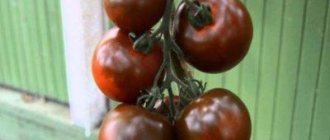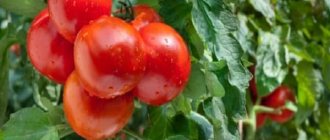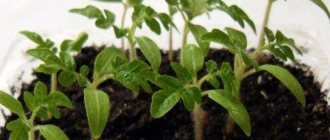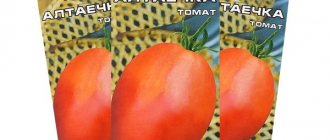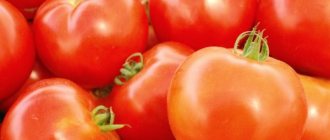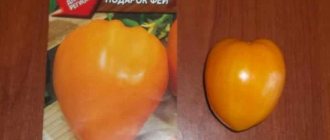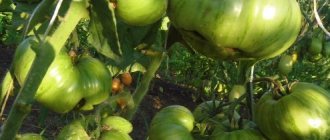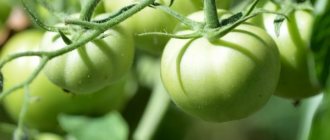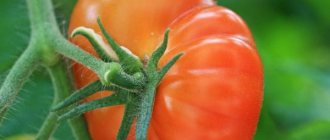Tomato Firebird F1 is a colorful hybrid of Siberian breeders. It is the embodiment of the best properties of tomatoes - delicious taste, presentable appearance, productivity. In addition, orange tomatoes contain high concentrations of carotenoids and lycopene, which makes them a valuable product for children and patients.
| Height | Landing location | Ripening time | Fruit color | Fruit size | Origin | Fruit shape |
| Medium height | Greenhouse, Open ground | Early ripening | Orange | Average | Hybrid | Flat-round |
Tomato Red buffalo - description and characteristics of the variety
The back of the Red buffalo is gigantic in size. The variety belongs to the hybrid group with early ripening. The first ripe fruits can be tasted 95-100 days after seed germination. Zanishtyak bushes grow in greenhouses and open areas. The variety will become unpretentious to unfavorable climatic conditions.
Description of the variety
The bushes of dupelinu plants are strong and have powerful roots and shoots. During growth they can reach a height of 2 meters. To avoid uncontrolled growth, which will negatively affect the quality of the crop, the top of the tuft needs to be pinched.
From one bush with fairly good care you can get from 9 to 10 kg of tomatoes. The impression of the fruit is flat-round. Hybrids grow in huge sizes, the weight of the fruit varies from 500 to 1000 grams. The pulp is fleshy and juicy. Fruit cravings are sweet.
Due to their gigantic size, tomatoes are not suitable for canning in their entirety, but they are excellent for making ketchups, pastes and juices. And to make vegetable rapunzel for a large family, one tomato will be enough.
Agrotechnics of cultivation
The category is grown in seedlings. Sowing is recommended in mid-May. Movra must be purchased in specialized stores every year. Uninhabited (=sparsely populated) hybrids retain the characteristics of the maternal genes, so after collecting the seeds yourself, nothing will grow from them.
Preparing for sowing
Seeds should be kept in a soda solution or potassium permanganate used for disinfection. This will help avoid the appearance of fungus on future bushes. After preparing the seeds, you need to hoe the soil and apply mineral fertilizers. The soil needs to be calcined at a high temperature in the oven. This will kill harmful insects, and get rid of many possible fungi and viruses. The prepared soil should be stored overnight in boxes or containers.
Planting and care
- Seeds should be sowed to a depth of 1 cm. They are placed in the grooves made. There is no need to drench the soil, just moisten it a little. From a bird's eye view, the box is covered with cellophane or glass. In order for the sprouts to hatch faster, you need to provide the future seedlings with optimal temperature and sunlight. As soon as the seedlings appear on the surface, the covering can be removed.
- When the seedlings form 2-4 leaves, they need to be picked. To achieve this, you need to plant the sprouts in separate containers.
- Shortly after planting in a greenhouse or in the ground, strengthened seedlings should be hardened off. After a week, you need to take the seedlings outside for quite a few hours. Immediately before planting, the containers are left outside overnight.
- In a permanent place it must be planted in already prepared soil. It is necessary to add humus or other organic matter to the holes in advance. Take one square meter and plant 3 seedlings. If there is not enough space, then the bushes will lack nutrients, which will have a negative impact on the future harvest.
- Near each hole you need to tie a wooden or metal stick to the horse, to which the bushes will be tied. During the growth period, timely removal of excess stepsons should be carried out.
During the amazing summer period, to obtain a richer harvest and healthy large fruits, you should follow the basic rules of care:
- Cultivate the soil and remove weeds in a timely manner.
- Water no more than once a week. Tomatoes do not like drought and too much water.
- Cultivate bushes to prevent diseases and pests.
- Apply mineral fertilizers several times a season.
If you follow simple care instructions, the results will be excellent. The most important thing is not to forget that the tomatoes will grow enormous in size, which means you will have to work hard with the preparations.
All gardeners are absolutely delighted with this variety. The red buffalo captivated everyone with its size and bright red color. Many are simply surprised how such giants, ignorant, break the bushes on which they hang. But the fact remains that the shoots are very strong and powerful.
Vitaly, 42 years old:
I was simply amazed by the size of the fruits of this variety. To make a salad for one person, Vodan tomato can be divided into several parts. Next year I will certainly plant Red Buffalo again.
Description
Adeline is a mid-season determinate variety. The growing season of the crop ranges from 110 to 115 days. Tomatoes are grown both in open and protected ground.
Interesting. The powerful bush reaches a maximum height of 50 cm. It forms up to 5 clusters, after which it stops growing. Does not require bush formation or pinching. However, it requires tying to a trellis.
The color of the leaves is rich green. Adeline's fruits have an attractive appearance. They are distinguished by their bright red color when ripe. The fruit weighs on average 85 g with a yield of up to 4 kg per 1 m2 of area. The shape of the tomato resembles a small oblong egg, the skin is dense, the flesh is fleshy with a sweet and sour taste.
Distinctive features of Adeline:
- Frost resistance. Ability to bear fruit at temperatures equal to 0 °C. Suitable for cultivation in Siberia and the Urals;
- Transportability. Not damaged during transportation;
- Disease resistance. Not affected by rot or fusarium;
- Insensitivity to drought. The foliage does not wither for a long time, the berries retain their presentation;
- Heat resistance. Tomatoes ripen quickly.
Summer residents note the universal purpose of the berries, which, due to their parameters, are suitable for canning and the production of tomato products. Tomatoes do not crack during heat treatment. When cutting vegetables, the pulp does not leak out. The skin does not spoil the sauce and juice.
Tomato Adelina is included in the State Register of the Russian Federation for the North Caucasus Federal District. Breeders advise growing the variety on private farms and in summer cottages.
Description of the tomato variety Klepa, features of cultivation and care
Compact bushes, clusters of identical beaded tomatoes, rich sweet taste - all this is the Klepa tomato. Cherry tomatoes have long conquered hearts and gardens with their friendly ripening and early ripening, as well as excellent decorative and table properties. Therefore, it is not surprising that every year interest in this type of tomato only grows, and with it the variety of varieties increases.
Features of the variety
Tomato variety Klepa is mid-season, indeterminate type. After 100–115 days, friendly shoots also begin to produce their harvest together.
Description of the plant:
- the bush is vigorous, can reach 2 m or more in height;
- medium-leafed plant, small, green leaves;
- inflorescence complex, stalk with articulation;
- Tomato yield is high - 7.5 to 8 kg per 1 sq. m;
- has increased resistance to tobacco mosaic virus.
Fruit characteristics:
- round, smooth shape;
- weight of tomatoes 20–25 grams;
- the skin is thin, strong and smooth;
- The color of ripe tomatoes is deep red;
- the pulp is dense, juicy;
- The taste of the tomato is sweetish, dessert.
Among other advantages of the variety, it should be noted its amazing shelf life - tomatoes can be stored for more than three weeks, do not spoil or lose their presentation.
Agricultural technology
The Klepa tomato variety is recommended for cultivation both in open ground and in greenhouse conditions. To grow tomatoes and reap a rich harvest, it is necessary to prepare high-quality planting material, so it is better to grow seedlings yourself:
- Seeds are sown at the end of March or beginning of April.
- Before sowing, it is advisable to soak the seeds in warm water, after wrapping them in gauze.
- Tomatoes are sown on slightly compacted soil, then sprinkled with a soil or peat layer of no more than 1 cm.
- Next, the crops should be carefully watered, covered with film and placed in a warm place.
- After the shoots emerge, the film should be removed and the young shoots should be provided with light and warmth.
- In the phase of the appearance of the first pair of true leaves, the sprouts need to be planted in separate cups or pots.
- One and a half to two weeks before planting in the ground, plants must begin to be hardened off, leaving young tomato bushes in the fresh air. This makes it easier for them to adapt to their permanent place of residence.
- At the age of 60–65 days, seedlings can be planted, provided that the threat of frost has passed.
- As the bushes grow, they need to be formed into two stems. And also, given the vigorous growth of plants, they should be tied to a trellis in advance, which will greatly facilitate subsequent harvesting.
- Klepa does not need abundant watering, so it is enough to ensure that the soil does not dry out. In addition to watering, plants respond well to fertilizing and loosening the soil.
The Klepa tomato is distinguished by its aesthetic beauty and dessert properties, because the fruits of this variety are easily confused with berries. And for growing it is not necessary to have a personal plot; Klepa has enough space on the balcony. You can easily verify this by reading reviews from experienced tomato growers who, even in winter, prefer to eat fresh tomatoes grown with their own hands.
Features of growing and caring for the variety, timing of planting seedlings
If cultivation is carried out in a greenhouse, year-round, the time for planting seedlings is determined as the fruiting of the previous plants ends. For open ground, seedlings need to be planted 50-60 days in advance. The planting date can be determined by calculations based on climatic conditions and the lunar calendar compiled for the growing region. The conditions applicable to all varietal tomatoes are also observed for the orange-golden “Fire Bird”.
Seedlings need picking if the seeds were planted in large containers. If you planted the seeds in separate available means (cups, plastic packaging or pots), picking can be avoided. Experts recommend moderate watering and root mulching to avoid excess moisture and retain water in the soil. Before planting, seedlings need hardening, per square meter. m plant 5-6 bushes.
The plant is not tall and bears fruit calmly even in close quarters. The harvest is harvested as it ripens, as soon as the tomatoes have reached yellow color. If the fruits are intended for sale, they can be collected in a state of technical ripeness.
Interesting! For bait, it is better to use folk recipes, because the variety is considered dietary. There are proven means to accelerate crop growth, for example, an aqueous solution of ash, iodine and boric acid infused for 24 hours (for 10 liters of warm water - a bottle of iodine, 10 g of boric acid and about 1 kg of ash). It is one of the popular folk growth stimulants with high efficiency.
Fertilize the Zhar Ptitsa variety according to the standard scheme:
- at the seedling stage - when the first leaves appear, to gain vegetative mass;
- refining in holes when planting in the ground;
- during flowering and ovary formation;
- after collecting the first harvest from the bush.
For reference! The producer of seed material is the Russian company SeDeK, which enjoys a deservedly high reputation. She monitors her products and produces them in original packaging. The bag may contain a different number of seeds; their number should be calculated taking into account the area on which the tomatoes will be planted.
Description of the tomato variety Vovchik, growing characteristics and yield
For lovers of short-growing tomatoes, there are many varieties with a height of no higher than 50 centimeters to grow. But not all of them boast abundant fruiting. Another thing is the Vovchik tomato, amateur gardeners leave positive reviews about this variety, let’s find out why.
Description of Vovchik tomatoes
The variety was bred by breeders for cultivation in open ground. The variety is early ripening - fruiting occurs 90–100 days after seed germination. The plant grows differently in different agricultural companies. "Aelita" is determinate, grows up to 50 centimeters. “Gossort” has an indeterminate, tall variety. When planting, this fact should be taken into account.
A determinate plant has small, green leaves. Requires pinching in the initial growing period.
The fruits are flat-round and vary in size. Up to 250 grams will be sown on the lower clusters, 100–120 grams on the higher ones. The taste is excellent, sweet with sourness, the flesh is slightly fresh, pale pink. From 4 to 6 seed chambers are formed in the fruit. When ripe, there is no green spot near the stalk. The productivity of the variety is high. Judging by the reviews, those who planted the bushes were strewn with fruits.
Suitable for universal use; due to its taste, it is consumed fresh and pickled. Vovchik will make delicious tomato juice and sauce.
Advantages
Thanks to its growth, the bush is compact, so it does not take up much space in the garden; therefore, a number of advantages can be highlighted:
- Convenient to care for and water.
- Tomatoes have a wonderful taste and aroma.
- These tomatoes are used to make any kind of canned food, and thanks to long-term storage, they are grown for sale.
- The variety is resistant to many diseases, such as fusarium and vercellosis.
- Does not require a garter.
Agrotechnics of cultivation
Tomatoes can be grown in seedlings, so before planting the plants in the ground, the seeds need to be germinated. Nowadays, peat tablets are popular. A seed is planted in them, watered and germinated under cellophane. When it sprouts, remove the cellophane and continue growing until two leaves appear.
After picking, the sprout along with the tablet is planted in separate glasses and sprinkled with earth. Grow before transplanting into the ground.
Depending on the region and place of cultivation, planting is carried out from early May to early June. Air temperature is taken into account. If planted during night frosts, the plants will die or grow poorly.
Further, during the growth of the plant, if necessary:
The main indicator of the need for watering is dry soil. Tomatoes cannot tolerate soil drying out, so frequent watering and loosening of the soil is necessary. Then the tomatoes will ripen faster and last longer.
Plant fertilizer is applied 3-4 times per season. Organic and mineral fertilizers are used. Plants are fed:
- During the period of seedling growth.
- After transplantation to the main place of growth (after 2 weeks).
- During flowering;
- When the tomatoes ripen.
When fertilizing, plants and fruits receive the nutrients necessary for the growth and ripening of fruits.
It is also important to monitor growth and development. Inspect the bushes
Anyone who has grown tomatoes knows that when rot or gray spots appear on any part of the bush, they are treated with fungicides. Earlier, without waiting for the disease to appear, preventive treatment of plants against diseases is carried out.
With proper care of tomato plants, you will definitely get a rich harvest of juicy and ripe tomatoes.
Tomato Firebird: characteristics of the variety, growing features, photo
Tomato Firebird is a variety of Siberian selection, one of many successful cold-resistant hybrids, the distinctive feature of which is always excellent yield and pleasant taste. Despite their hybrid origin, orange fruits have excellent vitamin content and are recommended for dietary nutrition due to their hypoallergenicity and high beta-carotene content.
Tomato Firebird is another excellent example of tomatoes from the SeDeK agricultural company, which enjoys a deservedly high reputation not only in the Russian Federation, but also abroad. The variety is included in the State Register of the Russian Federation and is recommended for cultivation under film cover and in greenhouses. It can be grown in the southern regions and in open ground. Low-growing (maximum 90 cm), it requires gartering and pinching, but with proper agricultural technology it produces up to 7 clusters, on each of which 5-7 fruits ripen, sometimes reaching a weight of 250 g. The standard weight for tomatoes is 120-130 g.
Characteristics and description of the variety, yield
Farmers invariably speak favorably about the commercial qualities of the variety and grow Firebird not only because the hybrid is resistant to almost all tomato diseases. The bush, despite its relatively small height, grows spreading and strong, with glossy golden-orange fruits on the clusters. According to gardeners, fruits collected from the bush have an excellent presentation.
Glossy skin, almost always without flaws, with the ability not to crack, dominant color and beneficial properties - all this speaks in favor of the variety. Tomatoes ripen quite early (the variety is classified as early ripening). They are harvested almost simultaneously, easily separated from the stalk, picked at technical ripeness, and have a pale green color.
Features of cultivation
Another feature of the Parsley Gardener variety is the ability to grow by cuttings. To do this, you can use both stepsons and the tops of branches, which need to be placed in water or damp soil for 10 days.
Thus, with a minimum number of seedlings, you can constantly increase it, and the fruiting period increases accordingly. In order to enjoy your tomatoes all winter, you can leave the bush indoors in a container, constantly breaking off and rooting the shoots. You will have your own fresh tomatoes on the table, and by spring there will already be mature plants.
- in twists;
- in two roots;
- in peat tablets;
- using Chinese technology;
- in bottles;
- in peat pots;
- without land.
If you still use the usual method of growing tomatoes, then the seeds for seedlings must be sown at the end of February or at the very beginning of March. After two leaves appear, the seedlings are planted, planted under film covers at the end of April, and in open ground in May. Read about growing seedlings without picking here.
When planting, a tablespoon of superphosphate or nitrophoska is added to each hole. Then, after 10 days, fertilizing must be repeated with complex fertilizers for tomatoes; spraying with a weak solution of potassium permanganate gives a good effect.
Fertilizing is done every 10-15 days; many gardeners use folk remedies; watering with yeast infusion has a very good effect. We must not forget that tomatoes do not like an excess of nitrogen fertilizers, i.e. fresh manure applied in large quantities gives growth of green mass (leaves), but reduces the number of ovaries.
Read more about fertilizers for tomatoes:
- Organic, mineral, phosphorus, complex and ready-made fertilizers for seedlings and the TOP best.
- Yeast, iodine, ammonia, hydrogen peroxide, ash, boric acid.
- What is foliar feeding and when picking, how to carry it out.
Characteristics and description of the variety, yield
Farmers invariably speak favorably about the commercial qualities of the variety and grow Firebird not only because the hybrid is resistant to almost all tomato diseases. The bush, despite its relatively small height, grows spreading and strong, with glossy golden-orange fruits on the clusters. According to gardeners, fruits collected from the bush have an excellent presentation.
Glossy skin, almost always without flaws, with the ability not to crack, dominant color and beneficial properties - all this speaks in favor of the variety. Tomatoes ripen quite early (the variety is classified as early ripening). They are harvested almost simultaneously, easily separated from the stalk, picked at technical ripeness, and have a pale green color.
Fact! Both ripe and not very ripe fruits can be located on the same cluster, which are also picked if long-term transportation or storage is required. When it reaches full ripeness, the hybrid loses neither its taste nor its beneficial components, for which it is in great demand.
When growing tomatoes for commercial profit, the yield of marketable products is up to 95%, taking into account all costs. Tomatoes can be removed from the bush with stalks, which reduces the use of containers for goods, but increases storage time, preserves taste and allows them to have a fresh, attractive presentation for longer. The main purpose of the variety is fresh consumption, but small fruits are also used for canning and pickling.
The variety has a long list of positive reviews from domestic gardeners and gardeners from neighboring countries. This gave rise to the inclusion in the State Register of tomato varieties approved for cultivation in the Central region, zones of unfavorable agriculture in greenhouses and film shelters, and planting in open ground in the south. The bush is formed into 1-2 stems; it is necessary to remove side shoots and part of the foliage to increase fruiting.
Domestic gardeners, when growing in greenhouses, prefer a two-stem formation, and consider gartering mandatory in order to keep the stem intact and prevent the fruits from being on the ground. Short period of seedling ripening (55-60 days). On soil without shelter, the bush turns out to be low, but strong, spreading, with green leafy mass, needs pinching, and bears fruit for a long time.
The tomato is intended for eating fresh, heat treatment and canning, and preparing healing juice for the winter used for diet therapy.
Advantages and disadvantages of the variety
The need for pinching, removal of layering and careful specific gartering should not be perceived as a disadvantage of a certain type of tomato. This feature is inherent in almost all varieties with spreading branches and massive foliage, even if they belong to determinate species.
The Firebird has many more advantages than its hypothetical disadvantages:
- in the greenhouse there is always excellent yield of up to 13.5 kg per square meter. m.;
- does not require additional manipulations and is easy to care for;
- stress resistance, susceptibility to cold and rainy climates;
- like any hybrid, it is resistant to common tomato diseases;
- fruits not only for universal use, but also for medicinal and dietary purposes;
- excellent shelf life;
- the ability to maintain presentation and freshness during long-term transportation;
- the possibility of gradual harvesting: ripe tomatoes, along with fruits of technical ripeness;
- original taste and few seeds;
- absence of greenish spots and defects on the stalk;
- The variety is tolerant of poor watering.
Tomato Zhar: characteristics and description of the variety, cultivation and care with photos
Growing crops for each summer resident has different goals. Eating fresh, canning, pickling or drying. This is where the variety selection comes from. Tomato Zhar was bred as a salad variety. Its fruits are smooth and beautiful and look great in winter preparations.
Criteria for the Zhar variety
The summer resident does not always have enough information provided by the manufacturer and looks for a more detailed description. With its help, he decides whether the variety is suitable for cultivation in his conditions and whether it meets the stated requirements.
Plant:
- Indeterminate.
- Height 1.5-1.8 m.
- Ripens in 115-125 days.
- There are 2-4 tomatoes in one brush.
Fetus:
- Flat-round shape.
- The color is bright red, similar to burning coals.
- Weighing 250-350 g.
- The density is high.
- Few seeds, many chambers.
- stored for 7 days, after which only for processing;
- Easily transports over any distance.
Whatever the characteristics of the tomatoes, there will definitely be a summer resident who will be satisfied with it, and he will turn all the disadvantages of the variety into advantages.
Landing
Growing tomatoes is no different. The seedling method is used. Seeds are sown early, about 2 months before the intended planting in the ground. Each summer resident calculates this period independently, since each region has different climatic conditions.
Seedlings require high-quality care, because strong plants are the key to a future harvest. Important:
- Watering.
- Temperature regime.
- Lighting.
- Feeding.
- Picking.
- Hardening.
Water in moderation, avoiding waterlogging or drying out. The temperature during the first 5 days is +18–20 ⁰С, after +20–26 ⁰С. Daylight hours are 14-16 hours; if there is a lack of natural light, lamps are installed.
When seedlings do not have enough light, the sprouts stretch upward, resulting in weak tomatoes.
Feed with growth stimulants or complex mineral fertilizers. Diving is carried out when the tomatoes grow 2 true leaves. Planting in separate containers helps plants form a powerful root system and a strong, strong stem.
Hardening is the final technique that prepares tomatoes for transplanting to a permanent location. 10 days before transferring to the ground, the seedlings are taken out onto the street or balcony, on the first day for 15-20 minutes, then increasing the time, bringing it up to 8-10 hours. When transplanting to a permanent place, place 3 plants per 1 m2.
Tomato care
Tomatoes are demanding in terms of formation; gardeners recommend growing the plant in 2-3 stems, removing the shoots. Tie to supports or trellis. Weeding helps save plants from attacks by insect pests and prevents the development of diseases.
Feeding is carried out at least 3 times, 7 days after transplantation, during flowering and fruiting. Fertilizers are alternated using organic matter and mineral complex fertilizers with a high phosphorus content.
Loosening and mulching the beds will help retain moisture in the soil longer.
Tomato immunity, productivity and household use
The resistance of tomatoes to diseases from the heat of burning coals is weak. Therefore, it is necessary to carry out timely treatment of plants to prevent the development of diseases.
When using chemicals, it is worth remembering that its use is rational only before the flowers appear. In the future, it becomes harmful to humans, as it is deposited in future fruits.
The yield is very high, up to 5 kg of tomatoes are harvested from 1 plant.
Tomatoes are used for preparing fresh salads, fillings for canning, juices, sauces and other methods of processing vegetables.
What do summer residents say about the Zhar burning coals variety?
Numerous reviews from gardeners are mostly positive. Vegetable growers praise the variety for its excellent taste and share their impressions.
Irina: “Wonderful tomatoes. Look great in dishes and salads. There are no difficulties during cultivation. The only problem is that it requires treatment for diseases. Otherwise, I really liked the variety.”
The heat of burning coals is a tomato that will appeal to all lovers of fresh salads
Tomato care
Tomatoes are demanding in terms of formation; gardeners recommend growing the plant in 2-3 stems, removing the shoots. Tie to supports or trellis. Weeding helps save plants from attacks by insect pests and prevents the development of diseases.
Feeding is carried out at least 3 times, 7 days after transplantation, during flowering and fruiting. Fertilizers are alternated using organic matter and mineral complex fertilizers with a high phosphorus content.
Loosening and mulching the beds will help retain moisture in the soil longer.
Planting raspberries Firebird
Raspberries can be planted in both spring and autumn. When planting in spring, the Firebird will give you a harvest this season. The placement of seedlings depends on your choice: to grow free-standing bushes or a continuous wall of raspberries.
Planting patterns depending on the method of raspberry formation:
- bush method: 1.5 m between bushes in a row and 2.5 m between rows;
- strip (trench): 50–70 cm in a row, 2.5 m between rows.
When growing in strips in subsequent years, form the growing raspberry tree so that there are 8–10 shoots per linear meter, that is, every 10–12 cm.
Traditionally, raspberries are grown using the strip method, but if there are few seedlings or the variety is being tested, use the bush planting method
Choose a place for raspberries that is sunny and covered by a solid fence or building from the northern winds. For better illumination, place the rows from south to north. When planting at the bottom of a hole or trench under each bush, add: 1/3 of a bucket of humus, 1 cup of ash or 1 tbsp. l. superphosphate and potassium sulfate. Mix the ingredients, make a layer of plain soil over them from the plot and plant raspberries. It is not recommended to bury the root collar. Water well and cover the plantings with mulch.
Growing and care
For an excellent harvest, this hybrid is grown in protected conditions in the northern regions, and in the middle zone and southern latitudes in open areas. The plant suffers from drought and heat and requires additional watering and shelter from the sun.
Sowing seeds and seedlings
Sowing seeds should begin in mid-March. But this is a rather arbitrary period, which depends on your climate and on where you are going to plant the seedlings in a permanent place. The period between the appearance of the first sprouts and planting of seedlings is 45-50 days.
- Since this variety is a hybrid, only seeds purchased in the garden departments of stores will be used for cultivation.
- Before planting, it is necessary to pickle the seeds by keeping them in a weak solution of potassium permanganate or hydrogen peroxide for 15-20 minutes, check for germination, and treat them with growth stimulants.
- Next, sowing in the prepared soil in the standard way, with exposure under film, in good light and a temperature of +21-25 ° C, with periodic ventilation and spraying with water.
- When the first leaves appear, pick them into separate cups with peat.
Before planting plants in permanent beds, harden the seedlings for several days at a temperature of +15-17°C, night temperatures are at least +10°C. Plant seedlings carefully by pouring them into holes from cups in a permanent place when consistently warm weather sets in, without frosts in May. The seedlings must be 50 days old and have at least five leaves on the plant. When replanting, be careful with the weak root system
And it’s better to get rid of weak shoots that are clearly inferior to other sprouts right away
When replanting, be careful with a weak root system. And it is better to get rid of weak shoots that are clearly inferior to other sprouts right away.
Planting and further care
Landing should be done as usual, subject to stable weather:
- Planting scheme: 4-6 bushes per 1m2.
- Immediately organize supports for further tying, because the fruits are expected to be large.
- Stepping is carried out only up to the first brush and is no longer required.
- Water carefully, without touching the stems and leaves, and always only with warm water. The plant does not tolerate drought. But even in waterlogged conditions there is a greater risk of getting sick. In protected conditions, water once a week, in unprotected conditions - 2 times a week. Increase watering on hot, dry days based on the condition of the soil.
- On the day of watering, do loosening and weeding. There is evidence that Lazy Guy tomatoes can do without this, but the yield will definitely be higher.
- Use fertilizers in a timely manner: there should be at least three of them throughout the entire season. At the same time, alternate organic matter with inorganic fertilizers.
- After about 90 days you can enjoy the first harvest.
Description of the Biathlon tomato and recommendations for growing
Tomato Biathlon F1 is a mid-early variety, the ripening period is 92-105 days from sowing the seeds for seedlings until the moment when the first harvest can be harvested. This is a very compelling argument for growing a plant in a city apartment.
What is a Biathlon F1 tomato?
Characteristics and description of the variety:
- This is a determinate tomato racem hybrid that can be grown both in open ground and in film shelters.
- The bush is medium-leafed, low-growing, no more than 0.8 m high, needs staking and pinching. It is necessary to form it into 2-3 stems, this will increase the amount of harvest.
- The first inflorescence appears above 8-9 leaves, subsequent ones - after 1-2 leaves.
- After the formation of 2-6 inflorescences, the shoots and the stem itself stop growing, and the plant spends all its energy only on ripening the fruits.
The fruits have a round, smooth shape, their weight is from 80 to 100 g, at the ripe stage they are red in color and have an excellent taste. They can be consumed fresh and also used for further processing, including canning. This hybrid variety is resistant to many diseases, including the tobacco mosaic virus.
How to grow tomatoes?
Sowing the seeds must be done 50-55 days before the intended planting in the ground, that is, if you plan to plant tomatoes in mid-June, then sow the seeds no later than mid-April. When 1-2 true leaves appear, the sprouts must be planted in separate containers to form a correct and stronger root system.
Approximately 2 weeks before the expected date of planting in the ground, it is necessary to begin hardening off the plants. First, you need to take them outside for a short time and add more time every day. Before planting tomatoes in open ground, you need to make sure that the average daily temperature does not fall below +12 °C. It is necessary to follow the planting scheme - 50x40 cm, density per 1 m² - no more than 7-9 plants.
Tomato Firebird reviews
photo author Vera Monakhova
Description of tomato Firebird F1, reviews, photos
Early ripening (95-105 days from germination to the beginning of ripening), determinate, productive tomato hybrid. Recommended for growing in open ground and under film covers.
The height of the bush is 0.7-0.9 meters, it requires staking and pinching. Up to 5 clusters are formed on the main stem, with 5-7 fruits in each. The first inflorescence is laid above 6-7 leaves, subsequent ones every 1-2 leaves.
Fruit characteristics
photo author Liliya Naumova
The fruits are round, smooth, beautiful, orange in color at maturity, weighing 130-150 grams, good (for a hybrid) taste. These tomatoes are suitable for fresh consumption, as well as for making very healthy juice (as these tomatoes have a high content of beta-caratine and vitamin C).
Productivity per 1 sq. meters up to 13 kg of fruit (with proper agricultural technology).
The advantages of this hybrid : resistance to the tobacco mosaic virus, tolerance to Alternaria, cold resistance, good fruit set even in cool, cloudy weather, high marketability and transportability of fruits.
Features of cultivation
Sowing seeds for seedlings is carried out 55-60 days before the intended planting in the ground. When planting seedlings per 1 sq. meter there are up to 6 plants.
If you grew Firebird tomatoes, please write what you liked about this hybrid, and why it perhaps disappointed you. Will you grow it again? If possible, attach a photo of these tomatoes. Thank you!
Your reviews of the Firebird tomato and additions to the description will help many gardeners evaluate this hybrid more objectively and decide whether it is worth planting or not.
Tomato Firebird is a variety of Siberian selection, one of many successful cold-resistant hybrids, the distinctive feature of which is always excellent yield and pleasant taste. Despite their hybrid origin, orange fruits have excellent vitamin content and are recommended for dietary nutrition due to their hypoallergenicity and high beta-carotene content.
Tomato Firebird is another excellent example of tomatoes from the SeDeK agricultural company, which enjoys a deservedly high reputation not only in the Russian Federation, but also abroad. The variety is included in the State Register of the Russian Federation and is recommended for cultivation under film cover and in greenhouses. It can be grown in the southern regions and in open ground. Low-growing (maximum 90 cm), it requires gartering and pinching, but with proper agricultural technology it produces up to 7 clusters, on each of which 5-7 fruits ripen, sometimes reaching a weight of 250 g. The standard weight for tomatoes is 120-130 g.
Characteristics and description of the variety, yield
Farmers invariably speak favorably about the commercial qualities of the variety and grow Firebird not only because the hybrid is resistant to almost all tomato diseases. The bush, despite its relatively small height, grows spreading and strong, with glossy golden-orange fruits on the clusters. According to gardeners, fruits collected from the bush have an excellent presentation.
Glossy skin, almost always without flaws, with the ability not to crack, dominant color and beneficial properties - all this speaks in favor of the variety. Tomatoes ripen quite early (the variety is classified as early ripening). They are harvested almost simultaneously, easily separated from the stalk, picked at technical ripeness, and have a pale green color.
Fact! Both ripe and not very ripe fruits can be located on the same cluster, which are also picked if long-term transportation or storage is required. When it reaches full ripeness, the hybrid loses neither its taste nor its beneficial components, for which it is in great demand.
When growing tomatoes for commercial profit, the yield of marketable products is up to 95%, taking into account all costs. Tomatoes can be removed from the bush with stalks, which reduces the use of containers for goods, but increases storage time, preserves taste and allows them to have a fresh, attractive presentation for longer. The main purpose of the variety is fresh consumption, but small fruits are also used for canning and pickling.
The variety has a long list of positive reviews from domestic gardeners and gardeners from neighboring countries. This gave rise to the inclusion in the State Register of tomato varieties approved for cultivation in the Central region, zones of unfavorable agriculture in greenhouses and film shelters, and planting in open ground in the south. The bush is formed into 1-2 stems; it is necessary to remove side shoots and part of the foliage to increase fruiting.
Domestic gardeners, when growing in greenhouses, prefer a two-stem formation, and consider gartering mandatory in order to keep the stem intact and prevent the fruits from being on the ground. Short period of seedling ripening (55-60 days). On soil without shelter, the bush turns out to be low, but strong, spreading, with green leafy mass, needs pinching, and bears fruit for a long time.
The tomato is intended for eating fresh, heat treatment and canning, and preparing healing juice for the winter used for diet therapy.
Advantages and disadvantages of the variety
The need for pinching, removal of layering and careful specific gartering should not be perceived as a disadvantage of a certain type of tomato. This feature is inherent in almost all varieties with spreading branches and massive foliage, even if they belong to determinate species.
The Firebird has many more advantages than its hypothetical disadvantages:
- in the greenhouse there is always excellent yield of up to 13.5 kg per square meter. m.;
- does not require additional manipulations and is easy to care for;
- stress resistance, susceptibility to cold and rainy climates;
- like any hybrid, it is resistant to common tomato diseases;
- fruits not only for universal use, but also for medicinal and dietary purposes;
- excellent shelf life;
- the ability to maintain presentation and freshness during long-term transportation;
- the possibility of gradual harvesting: ripe tomatoes, along with fruits of technical ripeness;
- original taste and few seeds;
- absence of greenish spots and defects on the stalk;
- The variety is tolerant of poor watering.
Features of growing and caring for the variety, timing of planting seedlings
If cultivation is carried out in a greenhouse, year-round, the time for planting seedlings is determined as the fruiting of the previous plants ends. For open ground, seedlings need to be planted 50-60 days in advance. The planting date can be determined by calculations based on climatic conditions and the lunar calendar compiled for the growing region. The conditions applicable to all varietal tomatoes are also observed for the orange-golden “Fire Bird”.
Seedlings need picking if the seeds were planted in large containers. If you planted the seeds in separate available means (cups, plastic packaging or pots), picking can be avoided. Experts recommend moderate watering and root mulching to avoid excess moisture and retain water in the soil. Before planting, seedlings need hardening, per square meter. m plant 5-6 bushes.
Description of the Red Buffalo tomato variety, growing characteristics and yield
The Red Buffalo tomato will help you fulfill your dream and grow not only the largest, but also the most delicious tomatoes. The description of the variety will allow you to become familiar with the characteristics of the hybrid and tell you how to get a rich harvest with a minimum of effort.
Features of the hybrid
Tomato Red buffalo F1 is a super-large-fruited hybrid of indeterminate type. It is characterized by early ripeness; the first harvest can be harvested after only 95–100 days from germination.
- the bush is powerful and strong, has no tendency to break off or bend;
- the growth of the bush is unlimited, it can reach more than 2 meters in height, so it needs to be pinched at the top;
- the plant is leafy enough to protect the fruits from the scorching sun;
- despite the small number of ovaries, the tomato yield is high - from 8 to 10 kg per bush;
- temperature changes do not affect development and fruiting;
- The hybrid is resistant to most tomato diseases.
- the shape of the tomatoes is flat-round;
- weight of heavyweight tomatoes is from 500 to 1000 grams;
- at the stage of full maturity, the color of the fruit is bright red;
- the pulp is fine-grained, juicy and fleshy;
- the taste of tomatoes is delicate and sweet, with a pleasant aftertaste.
The Red Buffalo tomato is mainly intended for salads and raw consumption. Due to their gigantic size, tomatoes are not suitable for whole-fruit pickling, but due to their juiciness and rich taste, Buffalo makes excellent sauces and juice.
Agricultural technology
Tomato variety Red Buffalo F1 is recommended for cultivation throughout Russia. Buffalo grows and bears fruit with equal success both in greenhouses and in open ground. Recommendations for cultivation and care are standard:
Sowing seeds for seedlings is carried out from mid-March to the end of April, depending on climatic conditions and the future habitat of tomato bushes.
- Seedlings are picked after the first pair of true leaves appear.
- To prevent the sprouts from stretching, the seedlings should be provided with uniform lighting.
- 7–10 days before the seedlings move to their permanent place of residence, the bushes should be “walked” in order to harden and facilitate adaptation after transplantation.
- Planting scheme - 3 bushes per 1 square. m. Due to denser planting, plants may develop a deficiency of nutrients and sunlight, which will negatively affect fruiting and yield.
- Tall tomatoes need tying and bush formation. You can tie up the bushes 3-4 days after planting them in the ground, when they are already sufficiently rooted and strong.
- The largest tomatoes grow when the bush is formed into one stem, but it is also possible to form into two stems.
- To prevent shallow development of the root system, the seedlings should not be watered for the first two weeks after planting. The roots will deepen and become stronger, making the plants stronger and more resilient.
Further, standard care methods apply: regular watering and loosening the soil, fertilizing the plants with organic fertilizers and mineral mixtures, periodically removing the lower leaves and shoots.
Tomato Firebird
photo author Vera Monakhova
Description of tomato Firebird F1, reviews, photos
Early ripening (95-105 days from germination to the beginning of ripening), determinate, productive tomato hybrid. Recommended for growing in open ground and under film covers.
The height of the bush is 0.7-0.9 meters, it requires staking and pinching. Up to 5 clusters are formed on the main stem, with 5-7 fruits in each. The first inflorescence is laid above 6-7 leaves, subsequent ones every 1-2 leaves.
Fruit characteristics
photo author Liliya Naumova
The fruits are round, smooth, beautiful, orange in color at maturity, weighing 130-150 grams, good (for a hybrid) taste. These tomatoes are suitable for fresh consumption, as well as for making very healthy juice (as these tomatoes have a high content of beta-caratine and vitamin C).
Productivity per 1 sq. meters up to 13 kg of fruit (with proper agricultural technology).
The advantages of this hybrid : resistance to the tobacco mosaic virus, tolerance to Alternaria, cold resistance, good fruit set even in cool, cloudy weather, high marketability and transportability of fruits.
Features of cultivation
Sowing seeds for seedlings is carried out 55-60 days before the intended planting in the ground. When planting seedlings per 1 sq. meter there are up to 6 plants.
If you grew Firebird tomatoes, please write what you liked about this hybrid, and why it perhaps disappointed you. Will you grow it again? If possible, attach a photo of these tomatoes. Thank you!
Your reviews of the Firebird tomato and additions to the description will help many gardeners evaluate this hybrid more objectively and decide whether it is worth planting or not.
Description and characteristics of the variety
The variety belongs to the mid-season tomatoes, ripens on 115-120 days from germination. The plant is indeterminate, 2.2-2.5 meters high; the growing season ends with frost. The bush produces quite a lot of shoots; when formed into 2-3 stems, the tomatoes do not become much smaller, but there are more of them.
For the ovaries to appear, the variety must be pollinated by insects. In a greenhouse, hand pollination is suitable.
The plant has a powerful stem and well-formed tassels, the internodes are small. The inflorescences are complex, in favorable weather they produce a lot of ovaries, sometimes 5-8 fruits or more. The leaves are light green, characteristic of a tomato shape. The laying of the first brush occurs after the 7th sheet, the next - after 1-3 sheets.
The taste of tomatoes is determined by many external factors. Depending on the care conditions, tomatoes can turn out sweet, sour, or sweet and sour.
The fruits are large, weighing 250-400 grams, flat-round in shape, multi-chambered, slightly ribbed. At the stage of biological ripeness, they are bright red, uniform in color. The taste of tomatoes is natural, tomato-like, rich and sweet. The skin is dense, cracking almost never occurs. The flesh is red and elastic. There are few seeds, especially in the first fruits.
Country of origin, year of registration
The variety was developed by a Russian amateur breeder. Babushkino tomatoes are not included in the State Register; they are reproduced only on private farms; large agricultural firms do not deal with this variety. Seeds can only be purchased from collectors.
